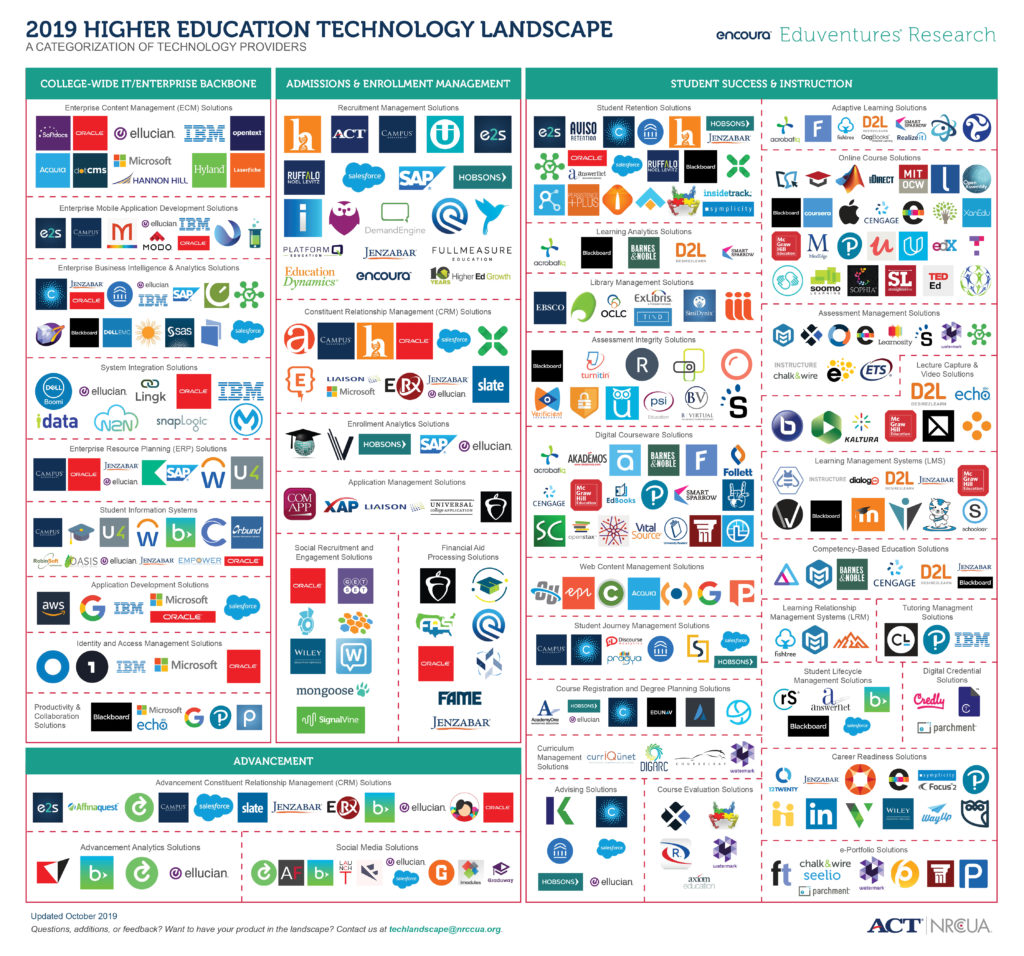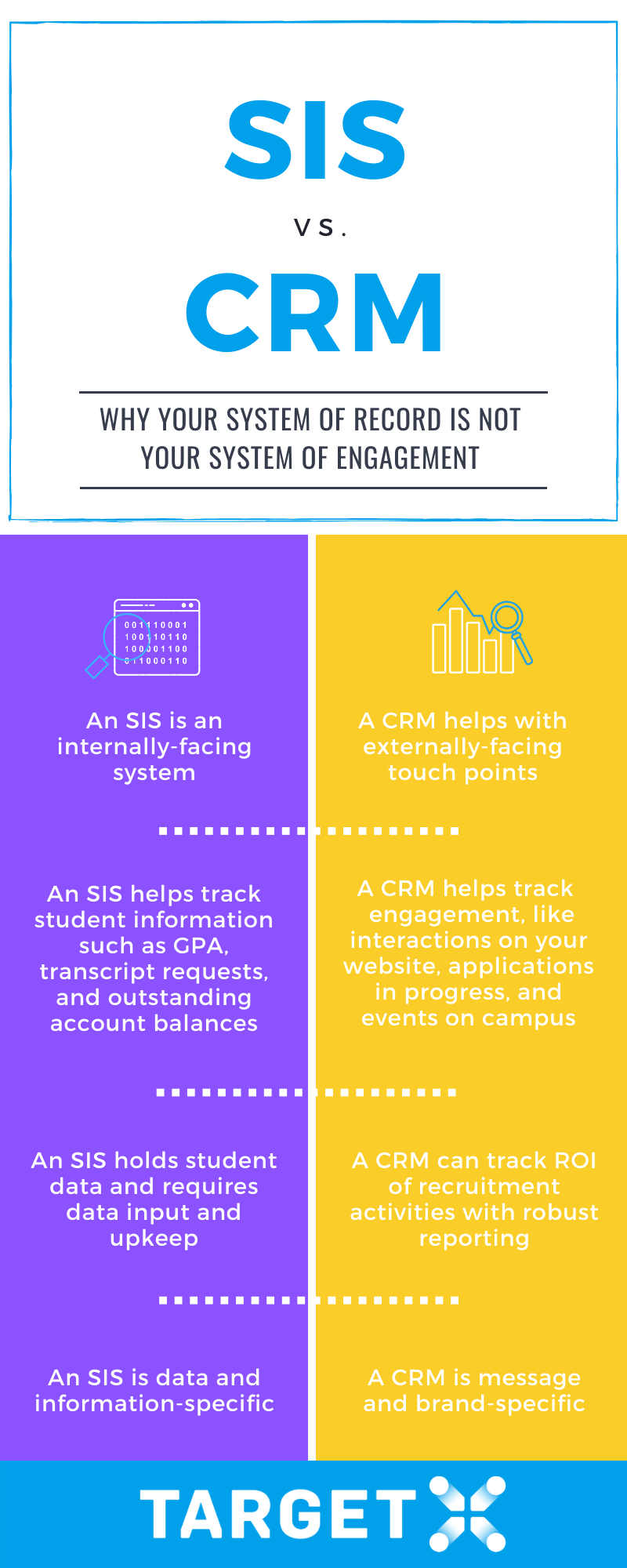When it comes to higher ed, there are so many software systems with so many different acronyms, it can be overwhelming when it comes time to make a decision or prioritize your choices. And of course, there’s also the budget to consider. With an increasing number of systems to choose from without an increase in the number of dollars to spend (check out Encoura’s latest snapshot of the industry below), it’s important to understand the ins and outs of all your choices, what ROI they can provide for your team, and why they’re not all the same.

Here’s why your Student Information System (SIS) is not your system of engagement.
>> Side note: If you’re already considering implementing a CRM for your admissions or enrollment team today, you need to download this buyer’s guide to help inform your strategy.
What’s the difference between SIS and CRM anyway?
In most college admissions offices, the SIS is the single source of truth for student data. While powerful, an SIS is an internally-facing system. Your SIS contains all of your school-specific metrics, as well as any data relating to students. Think of things like the number of students enrolled in a class, or transcripts and GPA information. Your SIS plays a large role in the maintenance and transference of information across campus. And while it’s an integral part of college admissions processes, your SIS simply informs larger messages and engagement strategies. Since an SIS can’t message outward, it plays no role in student-facing recruitment and enrollment activities.
Enter Customer Relationship Management software (CRM). CRM is a powerful tool for higher ed that helps drive recruitment strategy and admissions communication. Because CRM solutions integrate with existing platforms on campus, like websites and social media, it allows universities to have a better view of prospective students’ behavior, so that they can be nurtured and prioritized accordingly. With CRM, you’re also able to measure the ROI of admissions efforts and track patterns in student activity to drive further engagement and conversion. A CRM solution is a key component of recruiting and retaining students, and it takes the burden off internal team members so that they can focus on what really matters: the students. To learn more about TargetX’s Recruitment CRM solution, click here.
Can I have one without the other?
All institutions need an SIS to manage student data, that goes without question. And while you can have an SIS without a CRM, it’s not the best possible scenario. Here’s why:
Your SIS doesn’t provide a mobile-first student experience.
- The difference in user experience between the online application generated by your SIS and a CRM is night and day. (The enrollment management folks at the College of Charleston and Piedmont College recently touched on this in a webinar we hosted earlier this year.) Plus, the subsequent application review process is much cleaner and simpler with a CRM than with just an SIS. In a world where students are detracted from websites that look unappealing, a clean application that can be completed on mobile is critical to reducing abandoned applications.
You’ll need other third-party tools.
- Without a CRM, you’ll need to implement a collection of third-party tools (think MailChimp for email, Eventbrite for events… the list goes on and on) which means no way of tracking or centralizing all of this data on a single student record. This leaves your team with a disjointed student-facing experience, and multiple vendor relationships to juggle. Not to mention, this can be cost-prohibitive.
There’s no way to “future-proof” your SIS – it’s not a system that grows with you.
- Because your Student Information System isn’t necessarily a SaaS solution, this technology isn’t able to grow with you by design. Simply put, as you change up your recruitment and admissions approach, increase enrollment goals, and shift engagement priorities down the road, your SIS won’t be able to keep up. That’s the beauty of CRM – it’s a cloud-hosted, SaaS solution that continuously provides system upgrades and rolls out new functionality based on industry-wide best practices and customer feedback. Think of SIS as traditional (everyone has to have it) but CRM as transformational (the software that sets your campus apart). The power is in the platform.
There’s a lack of robust reporting to make data-driven decisions.
- An SIS stores your institution’s data but does not allow you to report on it without multiple Excel exports and manual data massaging. This makes it difficult, or even impossible, to make truly data-driven decisions to increase enrollment, better shape your future class, and/or improve retention rates. On the other hand, a CRM centralizes all your data and allows for robust reporting on everything from the enrollment funnel to student success metrics.
I know what you might be thinking: this sounds like a lot of work and back and forth managing two systems for recruitment and enrollment management. But don’t worry, communication between these systems through APIs allow for the seamless exchange of information from your SIS to your CRM, creating the strongest student lifecycle solution possible for your organization. This exchange also keeps the flow of work and information between departments up to date and organized so that less time can be spent populating and updating data fields, and more time can be focused on serving students.
Myth-busting the “all-in-one” approach: why one partner isn’t always the right answer!
It can definitely be tempting to use the CRM solution from your SIS provider to keep these systems under the same vendor umbrella. Integration has to be the easiest when it’s coming from two products by the same company, right? While this might feel like the path of least resistance, it’s not always the case. One vendor may be the best choice for your SIS and claim to support the entire student lifecycle with their tech stack, but that doesn’t necessarily make them the best or most seamless choice for a CRM.
In fact, your SIS can be integrated with outside, best-in-breed CRM providers with a similar investment of time and resources. This leaves you with the best possible system of engagement for your campus, allowing your team to put students first while increasing enrollment metrics and centralizing engagement data.

>> Interested in implementing a true system of engagement for your campus, but not sure where to get started? Check out our CRM Buyer’s Guide for Higher Ed!
